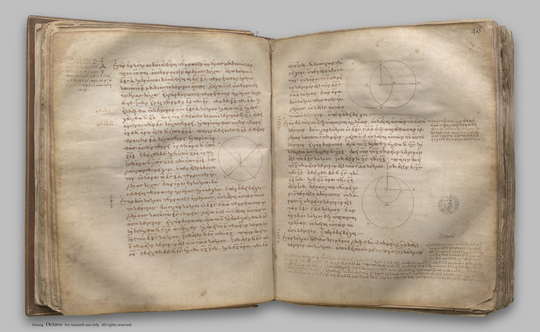index prev next | digilib folio 50

If two circles cut one another, they will not have the same centre.
| Ἐὰν δύο κύκλοι τέμνωσιν ἀλλήλους, οὐκ ἔσται αὐτῶν τὸ αὐτὸ κέντρον. Δύο γὰρ κύκλοι οἱ ΑΒΓ, ΓΔΗ τεμνέτωσαν ἀλλήλους κατὰ τὰ Β, Γ σημεῖα. λέγω, ὅτι οὐκ ἔσται αὐτῶν τὸ αὐτὸ κέντρον. Εἰ γὰρ δυνατόν, ἔστω τὸ Ε, καὶ ἐπεζεύχθω ἡ ΕΓ, καὶ διήχθω ἡ ΕΖΗ, ὡς ἔτυχεν. καὶ ἐπεὶ τὸ Ε σημεῖον κέντρον ἐστὶ τοῦ ΑΒΓ κύκλου, ἴση ἐστὶν ἡ ΕΓ τῇ ΕΖ. πάλιν, ἐπεὶ τὸ Ε σημεῖον κέντρον ἐστὶ τοῦ ΓΔΗ κύκλου, ἴση ἐστὶν ἡ ΕΓ τῇ ΕΗ: ἐδείχθη δὲ ἡ ΕΓ καὶ τῇ ΕΖ ἴση: καὶ ἡ ΕΖ ἄρα τῇ ΕΗ ἐστιν ἴση ἡ ἐλάσσων τῇ μείζονι: ὅπερ ἐστὶν ἀδύνατον. οὐκ ἄρα τὸ Ε σημεῖον κέντρον ἐστὶ τῶν ΑΒΓ, ΓΔΗ κύκλων. Ἐὰν ἄρα δύο κύκλοι τέμνωσιν ἀλλήλους, οὐκ ἔστιν αὐτῶν τὸ αὐτὸ κέντρον: ὅπερ ἔδει δεῖξαι. | If two circles cut one another, they will not have the same centre. For let the circles ABC, CDG cut one another at the points B, C; I say that they will not have the same centre. For, if possible, let it be E; let EC be joined, and let EFG be drawn through at random. Then, since the point E is the centre of the circle ABC, EC is equal to EF. [I. Def. 15] Again, since the point E is the centre of the circle CDG, EC is equal to EG. But EC was proved equal to EF also; therefore EF is also equal to EG, the less to the greater : which is impossible. Therefore the point E is not the centre of the circles ABC, CDG. |